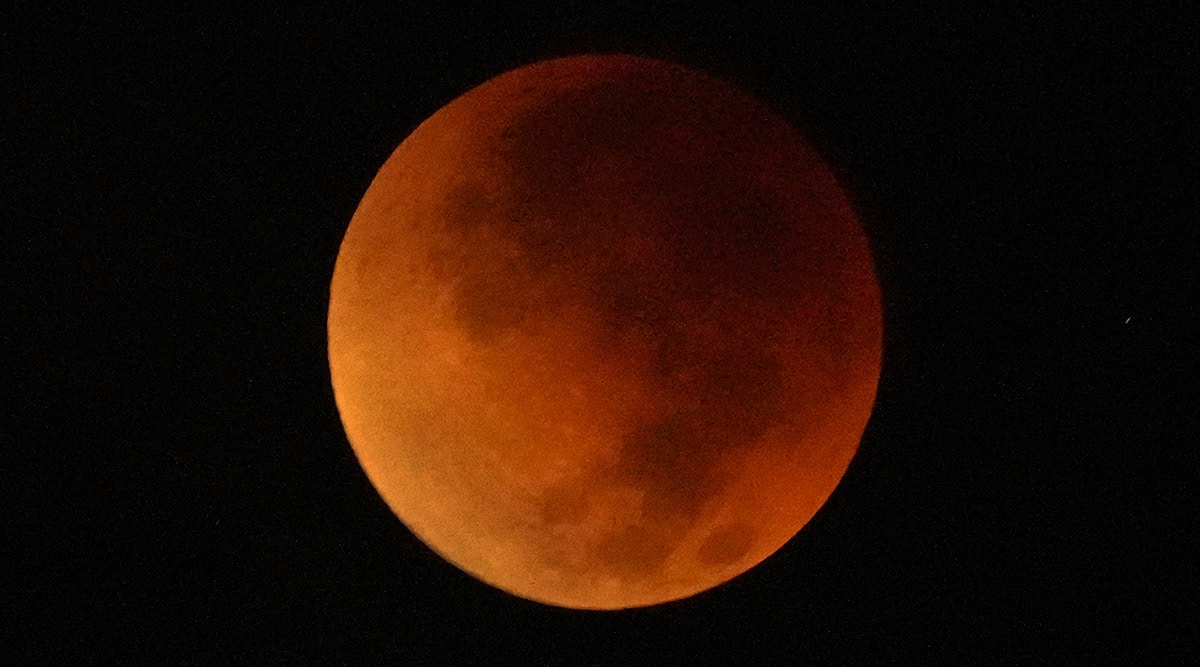 Blood Moon Lunar Eclipse 2022 Live: A total lunar eclipse graces the night skies during the first blood moon of the year, in Brasilia, Brazil, Sunday, May 15, 2022. (AP Photo/Eraldo Peres)
Blood Moon Lunar Eclipse 2022 Live: A total lunar eclipse graces the night skies during the first blood moon of the year, in Brasilia, Brazil, Sunday, May 15, 2022. (AP Photo/Eraldo Peres)Lunar Eclipse 2022 Today Live Updates: The first lunar eclipse of 2022 is almost over, and pictures of the event are now out, with the Moon taking on a stunning red colour. The eclipse, which was not visible in India, will be over by 12.30 IST and is now in the final phases.
This is also called a Super Moon and a Blood Moon as well. A Super Moon is a full moon and appears to be bigger than usual as it is closer to Earth thanks to its orbital position. It’s called a Blood Moon because Earth’s satellite takes on a reddish colour due to the Rayleigh scattering effect. This is because the Earth blocks sunlight from reaching the moon, but since the colour red has a longer wavelength some of it can still reach our satellite and making the moon appear red.
The ‘reddish tinge’ is more pronounced when there is more dust in the sky, according to NASA. The eclipse was visible in the eastern half of the United States and all of South America, some part of Europe and Africa as well. Most of Asia could not view the celestial event.


Yes, unlike a solar eclipse one can view the lunar eclipse with their eyes, no extra protection is needed. Those who have a telescope or a pair of binoculars can always get a 'closer look'. In India too, while there's no lunar eclipse tonight, one can always catch a glimpse of the full moon later tonight, provided the sky is clear.
Below are pictures of the lunar eclipse taken in other countries from US to Turkey to Mexico.
The next lunar eclipse takes place on November 8, 2022. This one is visbile in Asia, Australia, Pacific and Americas. This is also a total lunar eclipse. Only parts of India will be able to see the November eclipse at Moonrise, according to NASA's chart.
The lunar eclipse of May 2022 is a 'total lunar eclipse.' The reason is because thee Moon moves into the inner part of Earth’s shadow, or the umbra and is totally covered. This is also the reason the Moon turns red because the Earth's atmosphere scatters the sunlight from reaching the moon and only red light--which has a longer wavelength-- reaches it.
In a partial lunar eclipse, there is imperfect alignment of Moon, Sun and Earth, according to NASA.
The lunar eclipse is not visible everywhere on Earth. And nor do we see an eclipse each month. The reason the Moon's orbit around the planet is tilted relative to Earth's orbit around the Sun. This is the reason why we have occasional eclipses instead of eclipses every month, according to NASA.
The lunar eclipse is not visible everywhere on Earth. And nor do we see an eclipse each month. The reason the Moon's orbit around the planet is tilted relative to Earth's orbit around the Sun. This is the reason why we have occasional eclipses instead of eclipses every month, according to NASA.
Lunar Eclipse as seen in Venezuela. As you can the moon has a reddish colour thanks to the Lunar eclipse.
Take a look at how stunning the Moon looks in Brazil. This picture captures the eclipse in action and you can see the Earth's shadow on the Moon
A lunar eclipse takes place when the Earth comes between the Moon and the Sun, resulting in a total blocking of sunlight reaching the moon. But this also ensures that the moon takes on a reddish hue. In fact, this lunar eclipse is also called a 'Blood Moon' given how prominent the colour red is. You can see in the picture above, the moon is already red in Los Angelese.
So why does the Moon turn red? Well it is because of the 'Rayleigh scattering' effect. Only the red light which has a longer wavelength is able to travel to the moon as the Earth’s atmosphere scatters sunlight during the eclipse. NASA notes that the 'more dust or clouds in Earth’s atmosphere during the eclipse, the redder the Moon will appear.'
The Lunar eclipse is not visible in India. But as we've pointed out there are livestream channels to watch the event. Of course, the best one is from NASA, the US space agency. We have embedded the link on top below. NASA is streaming the event live from various locations where the eclipse is visible.